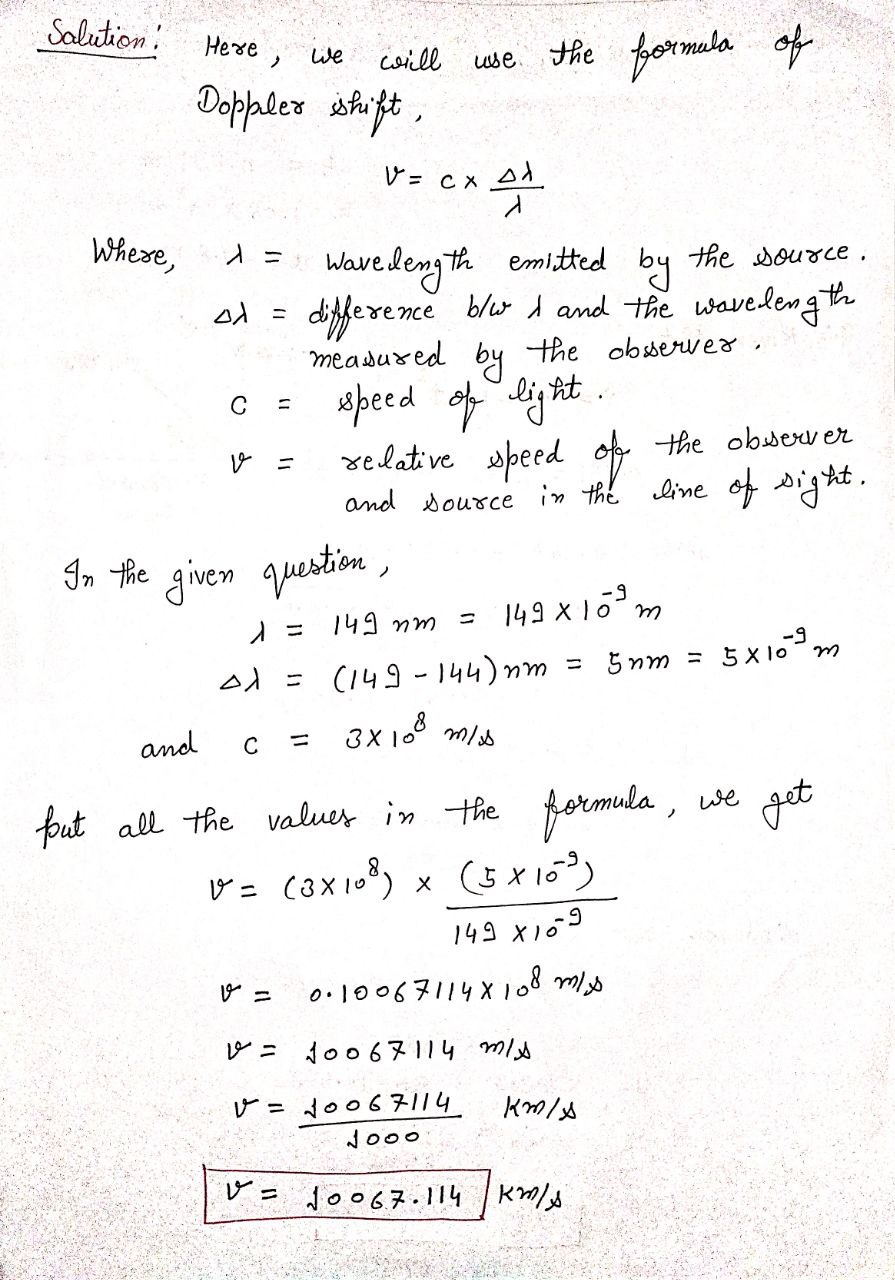
College Physics
11th Edition
ISBN: 9781305952300
Author: Raymond A. Serway, Chris Vuille
Publisher: Cengage Learning
expand_more
expand_more
format_list_bulleted
Concept explainers
Question
At rest hydrogen has a spectral line at 149nm. If this line is observed at 144 nm for the star proxima how fast is proxima moving in km/s
Expert Solution
arrow_forward
Step 1

Step by stepSolved in 2 steps with 1 images

Knowledge Booster
Learn more about
Need a deep-dive on the concept behind this application? Look no further. Learn more about this topic, physics and related others by exploring similar questions and additional content below.Similar questions
- A Type Ia supernova is observed and achieves an apparent magnitude of m = 19.89 at peak brightness. The absolute magnitudes of Type Ia supernovae at peak brightness are known to be M=−19. Determine the distance to the supernovae in units of Mpc.arrow_forwardhelparrow_forwardA main sequence star of mass 25 M⊙has a luminosity of approximately 80,000 L⊙. a. At what rate DOES MASS VANISH as H is fused to He in the star’s core? Note: When we say “mass vanish '' what we really mean is “gets converted into energy and leaves the star as light”. Note: approximate answer: 3.55 E14 kg/s b. At what rate is H converted into He? To do this you need to take into account that for every kg of hydrogen burned, only 0.7% gets converted into energy while the rest turns into helium. Approximate answer = 5E16 kg/s c. Assuming that only the 10% of the star’s mass in the central regions will get hot enough for fusion, calculate the main sequence lifetime of the star. Put your answer in years, and compare it to the lifetime of the Sun. It should be much, much shorter. Approximate answer: 30 million years.arrow_forward
- Problem Set on Binary Systems: 1.Consider two stars in orbit about a mutual center of mass. If a1 is the semimajor axis of the orbit of star of mass m, and a, is the semimajor axis of the orbit of star of mass m2, prove that the semimajor axis of the orbit of the reduced mass is given by a = a, + a2. points)arrow_forwardIf a star has a parallax of 0.050 arc second, what is its distance in pc?arrow_forwardTime left 1:45:56 A star has initially a radius of 680000000 m and a period of rotation about its axis of 33 days. Eventually it changes into a neutron star with a radius of only 45000 m and a period of 0.3 s. Assuming that the mass has not changed, find Assume a star has the shape of a sphere. (Suggestion: do it with formula first, then put the numbers in) [Recommended time : 5-8 minutes] (a) the ratio of initial to final angular momentum (Li/Lf) Oa. 2.17E+15 Ob. 24 Oc. 0.0416 Od. 4.61E-16 (b) the ratio of initial to final kinetic energy Oa. 4.85E-23 Ob. 396000 Oc. 2.53E-6 Od. 2.06E+22arrow_forward
- Calculate the redshift of a star if H-ß line of hydrogen from the star is observed to be 800 nm.arrow_forwardStudying the spectrum of a star, we see that the Haline (l= 656.285nm) has been shifted to 656.286 nm. Is the star moving towards us or away (explain your answer) How fast is the star moving with respect to us?arrow_forwardA star is observed to have a parallax 0.45". Show that it is a distance of 7.2 LY away.arrow_forward
- RR Lyrae stars have essentially the same luminosity curve, with periods of up to 1 day. False True 47arrow_forwardAt the distance of Earth, 1AU, the Sun's apparent brightness in the sky is about 1250 W/m 2 . What is the brightness that we would measure from a distance of 0.5 AU? What is the brightness that we would measure from a distance of 2.0 AU?arrow_forward
arrow_back_ios
arrow_forward_ios
Recommended textbooks for you
 College PhysicsPhysicsISBN:9781305952300Author:Raymond A. Serway, Chris VuillePublisher:Cengage Learning
College PhysicsPhysicsISBN:9781305952300Author:Raymond A. Serway, Chris VuillePublisher:Cengage Learning University Physics (14th Edition)PhysicsISBN:9780133969290Author:Hugh D. Young, Roger A. FreedmanPublisher:PEARSON
University Physics (14th Edition)PhysicsISBN:9780133969290Author:Hugh D. Young, Roger A. FreedmanPublisher:PEARSON Introduction To Quantum MechanicsPhysicsISBN:9781107189638Author:Griffiths, David J., Schroeter, Darrell F.Publisher:Cambridge University Press
Introduction To Quantum MechanicsPhysicsISBN:9781107189638Author:Griffiths, David J., Schroeter, Darrell F.Publisher:Cambridge University Press Physics for Scientists and EngineersPhysicsISBN:9781337553278Author:Raymond A. Serway, John W. JewettPublisher:Cengage Learning
Physics for Scientists and EngineersPhysicsISBN:9781337553278Author:Raymond A. Serway, John W. JewettPublisher:Cengage Learning Lecture- Tutorials for Introductory AstronomyPhysicsISBN:9780321820464Author:Edward E. Prather, Tim P. Slater, Jeff P. Adams, Gina BrissendenPublisher:Addison-Wesley
Lecture- Tutorials for Introductory AstronomyPhysicsISBN:9780321820464Author:Edward E. Prather, Tim P. Slater, Jeff P. Adams, Gina BrissendenPublisher:Addison-Wesley College Physics: A Strategic Approach (4th Editio...PhysicsISBN:9780134609034Author:Randall D. Knight (Professor Emeritus), Brian Jones, Stuart FieldPublisher:PEARSON
College Physics: A Strategic Approach (4th Editio...PhysicsISBN:9780134609034Author:Randall D. Knight (Professor Emeritus), Brian Jones, Stuart FieldPublisher:PEARSON

College Physics
Physics
ISBN:9781305952300
Author:Raymond A. Serway, Chris Vuille
Publisher:Cengage Learning

University Physics (14th Edition)
Physics
ISBN:9780133969290
Author:Hugh D. Young, Roger A. Freedman
Publisher:PEARSON

Introduction To Quantum Mechanics
Physics
ISBN:9781107189638
Author:Griffiths, David J., Schroeter, Darrell F.
Publisher:Cambridge University Press

Physics for Scientists and Engineers
Physics
ISBN:9781337553278
Author:Raymond A. Serway, John W. Jewett
Publisher:Cengage Learning

Lecture- Tutorials for Introductory Astronomy
Physics
ISBN:9780321820464
Author:Edward E. Prather, Tim P. Slater, Jeff P. Adams, Gina Brissenden
Publisher:Addison-Wesley

College Physics: A Strategic Approach (4th Editio...
Physics
ISBN:9780134609034
Author:Randall D. Knight (Professor Emeritus), Brian Jones, Stuart Field
Publisher:PEARSON